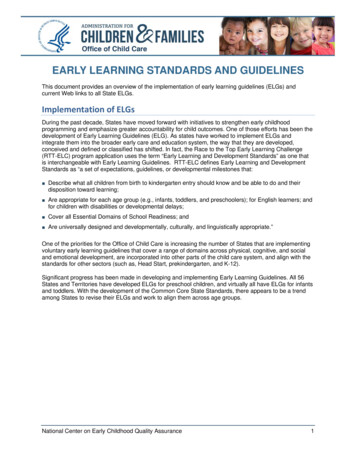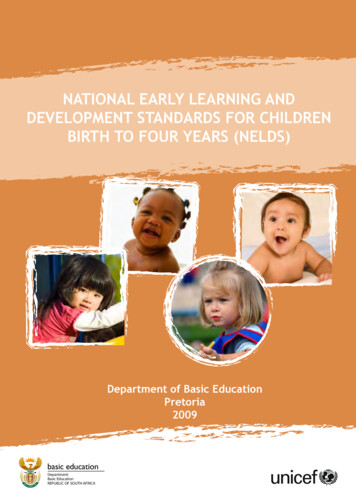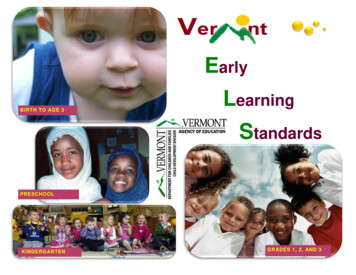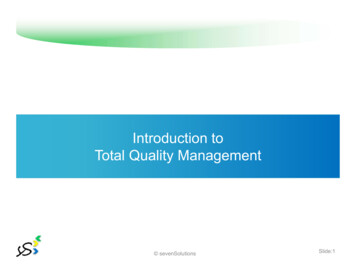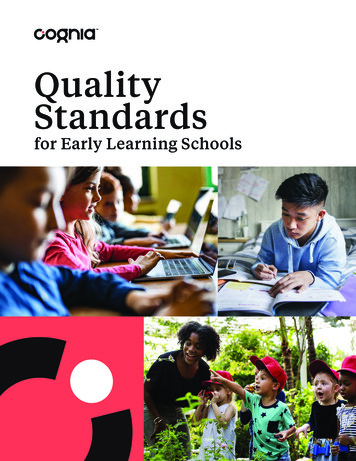
Transcription
QualityStandardsfor Early Learning Schools
Table of ContentsIntroduction . . . . . . . . . . . . . . . . . . . . . . . . . . . . . . . . . . . . . . . . . . . . . . . . . . . . . . . . . . . . . . . . . . . . iiAnatomy of a Standard . . . . . . . . . . . . . . . . . . . . . . . . . . . . . . . . . . . . . . . . . . . . . . . . . . . . . . . . . . . . 1The Standards . . . . . . . . . . . . . . . . . . . . . . . . . . . . . . . . . . . . . . . . . . . . . . . . . . . . . . . . . . . . . . . . . . 2Standards for the Future . . . . . . . . . . . . . . . . . . . . . . . . . . . . . . . . . . . . . . . . . . . . . . . . . . . . . . . . . . . 3Cognia Accreditation Protocols: Performance-Based Models . . . . . . . . . . . . . . . . . . . . . . . . . . . . . . . . 4Cognia Early Learning Protocol . . . . . . . . . . . . . . . . . . . . . . . . . . . . . . . . . . . . . . . . . . . . . . . . . . . . . . 5Summary of Standards and Indicators . . . . . . . . . . . . . . . . . . . . . . . . . . . . . . . . . . . . . . . . . . . . . . . . . 6Quality Standards for Early Learning SchoolsTable of Contentsi
IntroductionWe are what we repeatedly do. Excellence, then, is not an act, but a habit.—AristotleEach and every day, educators in early learning schools around theworld seek new ways to help young children learn and grow and reachtheir greatest potential. No longer are parents and communitiessatisfied with the minimum requirements. Educators must be preparedto meet this demand and continue to improve as they strive forexcellence.The commitment to continuous improvement is a dynamic effort,consistently requiring attention and revision. Cognia expects thiscommitment from the educational institutions we serve, and weexpect it of ourselves. To that end, once every five years, Cogniareviews, and revises if necessary, the Standards that serve as thefoundation of the Cognia Accreditation Process.These Cognia Standards for Quality Early Learning Schools not onlyprovide the foundation for the Cognia Accreditation Process, but alsorepresent the continued evolution of accreditation as a powerful toolfor driving effective practices in support of young children.About CogniaThe world’s leader in accreditation and schoolimprovement, Cognia believes that young children mustbe prepared to succeed in a constantly-evolving anddiverse world and that early learning schools have adeep responsibility to deliver a safe environment anddevelopmentally appropriate quality education to youngchildren from all walks of life.We have been experts in accreditation and schoolimprovement since 1895, and bring this 100 yearsof experience and expertise through three US-basedaccreditation agencies — the North Central AssociationCommission on Accreditation and School Improvement(NCA CASI), the Northwest Accreditation Commission(NWAC) and the Southern Association of Collegesand Schools Council on Accreditation and SchoolImprovement (SACS CASI).The Cognia Accreditation Process, a protocol embracedaround the world, is a clear and comprehensive programof evaluation and external review, supported by researchbased Standards, and dedicated to helping schools, schoolsystems, corporation systems, and education providerscontinuously improve.Cognia is committed to sharing the knowledge andpractice generated by schools throughout its globalnetwork to inform and influence practice on issues relatedto education quality.We believe in the power of education.Quality Standards for Early Learning SchoolsIntroductionii
Anatomy of a StandardCognia is fervently committed to the care and education of all youngchildren. In that regard, Cognia employs a research and performancebased protocol for early learning schools that commits to the care,education, learning, growth and development of young children.Cognia holds its accredited early learning schools accountable to highquality educational and childcare standards and results supported byan engagement of continuous improvement.The Cognia Standards for Quality Early Learning Schools provide thefoundation for the Cognia Accreditation Process. The Standards alsorepresent the continued evolution of accreditation as a powerful toolfor driving effective practices in support of young children.visionary; characterizing how early learning schools should operateto promote a culture of continuous learning that is fluid – engagingleaders, staff and parents. The Indicators are operational definitionsor descriptions of exemplary practices and processes, togetherproviding a comprehensive picture of each Standard. The Indicatorswill be scored individually through a set of Criteria. These Criteriacontain rich, detailed descriptors of what each Indicator looks like inpractice. The performance of each early learning school will be ratedon each Criteria as “Met” or “Not Met” based on evidence.The Cognia Standards for Quality Early Learning Schools arecomprised of Standards, Indicators and Criteria. The Standards areresearch-based, comprehensive quality statements that describeconditions that are necessary for early learning schools to achieveorganizational effectiveness and ensure young children learn andgrow. These Standards support an education process that is trulyTeaching and Assessingfor LearningGovernanceand LeadershipUsing Results forContinuous ImprovementResources andSupport SystemsPurpose andDirectionTogether, the Standards and accompanying Indicators and Criteria focus on childcare and educational best practices withinan early learning school that ensure student growth and organizational effectiveness. No one Standard or set of Indicators andCriteria is complete without considering all five as a collective whole. Their inherent connectedness is critical to understandingand application at each early learning school.Quality Standards for Early Learning SchoolsAnatomy of a Standard1
The StandardsStandard 1: Purpose and DirectionThe school maintains and communicates a purpose and directionthat commit to a sense of community and relationships among youngchildren and adults; developmentally appropriate cognitive, emotional,social, creative and physical growth and development; as well asshared values and beliefs about teaching, learning, development andcare for young children.Standard 2: Governance and LeadershipThe school operates under governance and leadership that promoteand support learning, growth and development in young children;family involvement; and school effectiveness.Standard 3: Teaching and Assessing for LearningThe school’s curriculum, instructional design and assessmentpractices guide and ensure teacher effectiveness and thedevelopmentally appropriate cognitive, emotional, social, creative, andphysical growth and development of young children.Standard 4: Resources and Support SystemsThe program has resources and provides services that support itspurpose and direction to ensure success for all children.Standard 5: Using Results for Continuous ImprovementThe school uses data about the developmentally appropriate learning,growth and development of young children and overall schooleffectiveness to guide continuous improvement.Quality Standards for Early Learning SchoolsThe Standards2
Standards for the FutureWe believe education can change the life of a child. We seek to serve extendedlearning programs that are dedicated to a standards-based approach toquality improvement for the ultimate benefit of their children and youth.—Dr. Mark A. Elgart President and CEO CogniaThrough our own commitment to improvement, Cognia revises itsStandards to ensure that they remain relevant and current as thefoundation of the Cognia Accreditation Process. There are verypractical reasons to review the Standards – our knowledge of effectivepractices changes, and research reveals new information about factorsthat contribute to student achievement and the learning, growth anddevelopment of young children.However, revising the Standards also opens the door to consideringfuture trends in education and Cognia’s own research and findingsfrom the institution visits at the nearly 30,000 accredited schoolsand school systems that we have conducted over the last five years.Feedback from the field also provided rich experiences and expertisethat allowed us to look at creating Standards for the future, not justtoday.This rich and deep revision process produced a set of Standardsthat will challenge early learning schools to commit to the care andeducational well-being of young children, to reach higher, to examinecloser and to demonstrate the fidelity and integrity of best practicesin early learning. The Standards for Quality Early Learning Schoolssignificantly increase the focus on teaching and learning; incorporate21st Century Skills related to early learning; embed high expectationsfor professional practice; and focus on developmentally appropriatecognitive, emotional, social, creative, and physical growth anddevelopment, as well as shared values and beliefs about teaching,learning, development and care for young children.Each Indicator has descriptive Criteria, and both schools and thevisiting External Review Teams will evaluate the institution against eachIndicator, not just the Standards.Key Educational Concepts in Standards1.All programs commit to developmentallyappropriate cognitive, emotional, social, creative,and physical growth and development, as wellas shared values and beliefs about teaching,learning, development and care for school agedchildren and youth.2.All programs sustain a learning culture thatpromotes high levels of engagement, creativity,innovation and collaborative problem-solving.3.All programs commit to developmentallyappropriate cognitive, emotional, social, creative,and physical growth and development, as wellas shared values and beliefs about teaching,learning, development and care for school agedchildren and youth.5.The governing body operates consistent withestablished roles and responsibilities; must beethical and free of conflict of interest.6. Curriculum, instruction and assessment areadjusted in response to data about children’s andyouth’s progress, needs, interests and strengths.7.Staff are trained in evaluation, interpretation anduse of data.8. Programs must demonstrate, using data, growthin child and youth learning, and achievement oflearning outcomes and program goals.9.Programs demonstrate effective collaborationwith children, youth, families, schools and thecommunity.4. The program’s improvement plan requiresidentification of goals for improvement oflearning and instruction.Quality Standards for Early Learning SchoolsStandards for the Future3
Cognia Accreditation Protocols:Performance-Based ModelsAll Cognia Accreditation Protocols are systematic, systemic andsustainable approaches to improving student performance resultsover time based on meeting Standards, engaging in continuousimprovement and implementing quality assurance. Early learningschools may pursue accreditation as individual schools or as part of asystem.Cognia Early Learning Accreditation for Schools is a researchedbased framework that supports the process of accreditation; providesa means to engage in continuous improvement; and involves theentire school community in a continuous process of self-evaluation,reflection and improvement. The process invites external scrutiny andwelcomes the constructive feedback of peers. The process demandsrigor, is based in data and approaches documentation of results withearly learning childcare and educational best practices.Cognia Early Learning Accreditation for School Systems is apowerful systems approach to improving learning, growth anddevelopment of young children as well as organizational effectivenessovertime. School System Accreditation recognizes that supportingchildren in their learning, growth and development is a result of howwell all the parts of the education system—the school or corporationsystem, early learning school and the learning environments —worktogether to meet the needs of children. School System Accreditationis used by school districts, corporations and dioceses.Quality Standards for Early Learning SchoolsCognia Accreditation Protocols: Performance-Based Models4
Cognia Early Learning ProtocolThe Cognia Early Learning Protocol is grounded in early learningresearch, incorporates the Cognia Standards for Quality Early LearningSchools, and includes both an ongoing Internal Review process andan External Review. Whether engaged in the individual early learningschool protocol or the systems protocol, each early learning school willconduct Internal Review and will host an External Review.Internal Review: The Cognia Protocol employs diagnostic tools forschools to conduct an Internal Review. These reviews are focused onevaluating performance related to the Cognia Standards, Indicators,Criteria and Stakeholder Feedback. The process of internal reflectionhelps schools move forward in their ongoing improvement efforts.Early learning schools have access to a variety of resources andsupport tools to assist the school in the accreditation process. CogniaField Consultants are available to mentor and provide assistance toindividual schools and systems.Each early learning school is responsible for collecting and analyzingevidence, updating the school’s demographics, and completing andsubmitting each of the following diagnostics in eProve: Assurances Self Assessment on Early Learning Standards, Indicators andCriteria Executive Summary Improvement PlanExternal Review: Each early learning school hosts an ExternalReview every five years as part of the school protocol or systemsprotocol. The External Review involves observations of the learningenvironments, provides focused feedback, and includes evaluationand validation of the school’s improvement efforts. During the ExternalReview, the Team reviews evidence relating to the school’s adherenceto the Cognia Accreditation Standards, Indicators and Criteria;progress in improvement efforts; and stakeholder feedback from staffand parents. If the school is part of a system, the External Review Teamalso gains knowledge about how the continuous improvement effortsof the system are implemented at the school level.The External Review spans two days. The team will spend two days ata school pursuing School Accreditation. For schools that are part ofa systems protocol, the team will remain at the school for a minimumof one day while spending the second day of the review gatheringadditional information about each school while onsite with the schoolsystem.The External Review Team is comprised of multiple team members,typically three to five individuals. Each team member contributes tospecific roles and responsibilities that address multiple purposes of theExternal Review. External Review Team members are required to betrained in the Cognia Accreditation Process through initial and updatetraining sessions.Accreditation Term: Per Cognia Policy, the final status of accreditationis granted by the Cognia Accreditation Commission. The accreditationterm is for five years.Evidence: As part of the Self Assessment, evidence is defined foreach of the Criteria. Evidences help school stakeholders to engage in adiscussion about how the school knows it is adhering to the Standards,Indicators and Criteria.Quality Standards for Early Learning SchoolsCognia Early Learning Protocol5
Summary of Standards andIndicatorsStandard 1: Purpose and DirectionThe school maintains and communicates a purpose and direction that commit to a sense of communityand relationships among young children and adults; developmentally appropriate cognitive, emotional,social, creative, and physical growth and development; as well as shared values and beliefs about teaching, learning, development, and care for young children.INDICATOR 1.01The school engages in a systematic, inclusive and comprehensive process to review, revise and communicatea school purpose for the care and developmentally appropriate learning, growth and development of youngchildren.Standard 2: Governance and LeadershipThe school operates under governance and leadership that promote and support learning, growth anddevelopment in young children, family involvement and school effectiveness.INDICATOR 2.01The school’s policies, practices and agreements ensure effective administration of the school.INDICATOR 2.02Leadership and staff foster a culture consistent with the school’s purpose and direction.INDICATOR 2.03Leadership engages defined stakeholder groups effectively in support of the school’s purpose and direction.INDICATOR 2.04Leadership and staff supervision and evaluation processes result in improved professional practice anddevelopmentally appropriate learning, growth and development of young children.Standard 3: Teaching and Assessing for LearningThe school’s curriculum, instructional design and assessment practices guide and ensure teacher effectiveness and the developmentally appropriate cognitive, emotional, social, creative and physical growthand development of young children.Quality Standards for Early Learning SchoolsSummary of Standards and Indicators6
INDICATOR 3.01The school’s curriculum includes challenging content and provides equitable and challenging learningexperiences that ensure the developmentally appropriate cognitive, emotional, social, creative and physicalgrowth and development of all young children and that lead to success at the next level.INDICATOR 3.02Curriculum, instruction and assessment are monitored and adjusted systematically in response to data aboutyoung children’s readiness, learning and development as well as examination of professional practice.INDICATOR 3.03Teachers engage young children in their learning through developmentally appropriate and effectiveinstructional strategies that address achievement of learning expectations.INDICATOR 3.04School leaders monitor and support the improvement of instructional practices of teachers to ensure youngchildren’s success.INDICATOR 3.05Mentoring, coaching and induction programs model best practices and support instructional improvementconsistent with the program’s values and beliefs about teaching and learning.INDICATOR 3.06The school engages families in meaningful ways in their children’s education and keeps them informed of theirchildren’s learning progress.INDICATOR 3.07Documenting, measuring and reporting young children’s learning, growth and development that represent theattainment of learning goals and content are consistent across the school’s developmental programs.INDICATOR 3.08All staff members participate in a continuous program of professional learning.INDICATOR 3.09The school provides and coordinates instruction to address the unique learning, growth and development needsof young children.Standard 4: Resources and Support SystemsThe program has resources and provides services that support its purpose and direction to ensure success for all children.INDICATOR 4.01The school employs qualified Administrators/Directors for each administrative position to support the school’spurpose, direction and educational program.Quality Standards for Early Learning SchoolsSummary of Standards and Indicators7
INDICATOR 4.02The school employs qualified teachers for each administrative position to support the school’s purpose, directionand educational program.INDICATOR 4.03The school maintains a class size and ratio of young children to teachers that support the care anddevelopmentally appropriate learning, growth and development of young children.INDICATOR 4.04Instructional time, material resources and fiscal resources are sufficient to support the purpose and direction ofthe early learning school.INDICATOR 4.05The school maintains facilities, services, and equipment to provide a safe, clean and healthy environment for allyoung children and staff.INDICATOR 4.06The school regularly assesses and maintains all indoor spaces to be accessible to all young children and adults;are ventilated, lighted and temperature-controlled; and the spaces that primarily serve each age-group of youngchildren have direct access to bathroom/washing facilities, sinks and drinking water.INDICATOR 4.07Each classroom learning space has sufficient, usable floor space and size to support the creativity anddevelopmentally appropriate learning, growth, and development of young children, is highly functional forprogram delivery, and encourages positive staff-to-child relationships.INDICATOR 4.08Each classroom/learning space has furniture, equipment and resources that are safe, clean, well- maintained,adaptive, accessible and developmentally appropriate for the age group of young children they directly serve,sufficient in number and organized in ways to support appropriate and effective implementation of the program.INDICATOR 4.09Indoor and outdoor equipment are safe and available to all young children, are developmentally appropriatefor the age-group, have appropriate surfaces to support a variety of types of learning and play, and have impactmaterial under all climbing equipment and swings.INDICATOR 4.10Each classroom/learning space has multiple learning interest centers that are organized for independent use byyoung children, support the learning activities of the instructional program and the creativity of young children,and are well-equipped with materials supportive of the purpose of each learning/interest center.INDICATOR 4.11Each classroom/learning space provides all children with safe and comfortable, cozy areas to relax, rest or sleepthat are continuously supervised by adults at all times.Quality Standards for Early Learning SchoolsSummary of Standards and Indicators8
INDICATOR 4.12Each classroom/learning space has displays that are used effectively as a learning tool, are developmentallyappropriate for the age-group, are attractively presented with appropriate content, portray the current learningactivities and showcase children’s work and creativity.INDICATOR 4.13The school provides support services to meet the physical, social and emotional needs of young children that areintegral to the educational program.INDICATOR 4.14Each child receives individual personal care by staff members who consistently promote the child’s general wellbeing, nutrition, health and safety.INDICATOR 4.15Arrival and departure routines focus on the care and well-being of each child and encourage a daily exchange offamily and school communications regarding the care, well-being and educational progress of the child.INDICATOR 4.16The school provides services that support the counseling, assessment and educational referral needs of youngchildren.INDICATOR 4.17All children, families and staff experience an environment of reciprocal respect, trust and open communicationin a fair and just way, respecting the needs and characteristics of each individual and promoting a sense ofcommunity, belonging, ownership and pride.INDICATOR 4.18All indoor and outdoor spaces are free from hazards and dangerous circumstances for young children and adults,and adults actively remove and resolve hazardous conditions as they may occur.Standard 5: Using Results for Continuous ImprovementThe school uses data about the developmentally appropriate learning, growth and development of youngchildren and overall school effectiveness to guide continuous improvement.INDICATOR 5.01Professional and support staff continuously collect, analyze and apply learning from multiple data sources,including comprehensive and trend data about the readiness, growth, development and learning of youngchildren as well as instruction, program evaluation and organizational conditions.Quality Standards for Early Learning SchoolsSummary of Standards and Indicators9
cognia.orgCopyright 2021 Cognia, Inc.
improvement and implementing quality assurance. early learning schools may pursue accreditation as individual schools or as part of a system. Cognia Early Learning Accreditation for Schools is a researched-based framework that supports the process of accreditation; provides a means to engage in continuous improvement; and involves the



